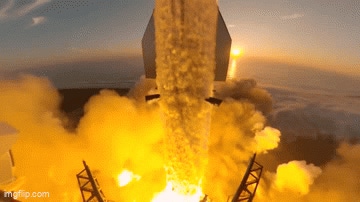
SpaceX’s third test flight of the reusable Super Heavy booster and Starship spacecraft made important advances in the company’s understanding of the performance of both systems, as real-time data and video streamed from the vehicles via the Starlink satellite network.
This resulted in amazing video of the Starship’s reentry, as hot plasma gas streamed past the camera. SpaceX president and COO Gwynne Shotwell also credited NASA’s TDRS satellite constellation for providing its usual telemetry stream for the flight.
SpaceX cited a list of firsts and achievements for this flight:
For the second time, all 33 Raptor engines on the Super Heavy Booster started and completed a full-duration burn during ascent.
Starship executed its second successful hot-stage separation
After lifting Starship into space, the Super Heavy booster completed its flip maneuver and boostback burn to send it towards its splashdown point in the Gulf of Mexico.
Super Heavy successfully re-fired several engines for its first-ever landing burn.
Starship's six second stage Raptor engines all started successfully and powered the vehicle to its expected orbit, becoming the first Starship to complete its full-duration ascent burn.
Starship executed the opening and closing of its payload door and initiated a propellant transfer demonstration between the header tank and the main tank.
Starship conducted its first-ever reentry from space, providing valuable data on heating and vehicle control during hypersonic reentry.
That was the positive side of the ledger for this test. For the “opportunities for improvement” portion of the review, there is the matter of both Super Heavy and Starship crashing.
The massive Super Heavy booster was planned to do a powered descent into the Gulf of Mexico, as SpaceX was understandably disinterested in bombing its drone landing ship with the potentially crashing remnants of a Super Heavy booster that muffed the landing attempt.
This proved to be prudent, because while Super Heavy succeeded in relighting some of its engines for landing, seemingly not enough of them lit, and it came down too fast. SpaceX says, without elaborating, that Super Heavy’s “flight concluded at approximately 462 meters in altitude.” As there is nothing to hit at that altitude, we’re left to guess that the range safety officer blew up the booster at that point.
Meanwhile, Starship continued on its way and achieved many mission milestones. But the vehicle was spinning about its longitudinal axis like a spiral football. Because they were unable to check this motion, SpaceX controllers decided to forego a planned on-orbit re-light of a single Raptor engine and went straight to reentry.
Starship has heat tiles on the side meant to be exposed to reentry friction, but because it was rolling, unprotected parts of the vehicle were scorched by the hot gases, with the result that “the flight test’s conclusion came during entry, with the last telemetry signals received via Starlink from Starship at approximately 49 minutes into the mission,” SpaceX drily observed in a post on the company’s web site.
Now the company’s engineers will pore over the data they retrieved from both the booster and Super Heavy to make adjustments for additional planned Starship test flights through the rest of the year.
About the Author(s)
You May Also Like





